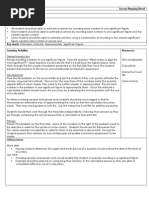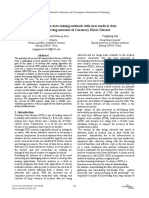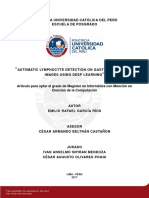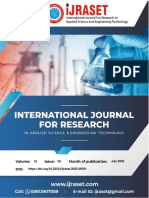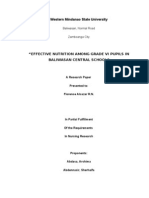0 ratings0% found this document useful (0 votes)
20 viewsResearch Paper
Research Paper
Uploaded by
CSE HODThis document summarizes a research paper that aims to detect lung nodules in medical images using the YOLOv7 (You Only Look Once version 7) deep learning model. The researchers developed a framework using YOLOv7 to enhance the identification of lung nodules in CT scans. Early detection of lung nodules is important for diagnosing conditions like cancer. The researchers believe YOLOv7 is well-suited for this task due to its real-time detection capabilities and high accuracy. The study seeks to improve lung nodule detection efficiency and accuracy to expedite diagnosis and improve patient outcomes.
Copyright:
© All Rights Reserved
Available Formats
Download as DOCX, PDF, TXT or read online from Scribd
Research Paper
Research Paper
Uploaded by
CSE HOD0 ratings0% found this document useful (0 votes)
20 views5 pagesThis document summarizes a research paper that aims to detect lung nodules in medical images using the YOLOv7 (You Only Look Once version 7) deep learning model. The researchers developed a framework using YOLOv7 to enhance the identification of lung nodules in CT scans. Early detection of lung nodules is important for diagnosing conditions like cancer. The researchers believe YOLOv7 is well-suited for this task due to its real-time detection capabilities and high accuracy. The study seeks to improve lung nodule detection efficiency and accuracy to expedite diagnosis and improve patient outcomes.
Original Description:
RESEARCH PAPER
Original Title
RESEARCH PAPER
Copyright
© © All Rights Reserved
Available Formats
DOCX, PDF, TXT or read online from Scribd
Share this document
Did you find this document useful?
Is this content inappropriate?
This document summarizes a research paper that aims to detect lung nodules in medical images using the YOLOv7 (You Only Look Once version 7) deep learning model. The researchers developed a framework using YOLOv7 to enhance the identification of lung nodules in CT scans. Early detection of lung nodules is important for diagnosing conditions like cancer. The researchers believe YOLOv7 is well-suited for this task due to its real-time detection capabilities and high accuracy. The study seeks to improve lung nodule detection efficiency and accuracy to expedite diagnosis and improve patient outcomes.
Copyright:
© All Rights Reserved
Available Formats
Download as DOCX, PDF, TXT or read online from Scribd
Download as docx, pdf, or txt
0 ratings0% found this document useful (0 votes)
20 views5 pagesResearch Paper
Research Paper
Uploaded by
CSE HODThis document summarizes a research paper that aims to detect lung nodules in medical images using the YOLOv7 (You Only Look Once version 7) deep learning model. The researchers developed a framework using YOLOv7 to enhance the identification of lung nodules in CT scans. Early detection of lung nodules is important for diagnosing conditions like cancer. The researchers believe YOLOv7 is well-suited for this task due to its real-time detection capabilities and high accuracy. The study seeks to improve lung nodule detection efficiency and accuracy to expedite diagnosis and improve patient outcomes.
Copyright:
© All Rights Reserved
Available Formats
Download as DOCX, PDF, TXT or read online from Scribd
Download as docx, pdf, or txt
You are on page 1of 5
DETECTION OF LUNG NODULES-USING YOLO v7
(You Only Look Once)
Shaik Nourin P Gayathri D Vasavi
Dept of CSDS Dept of CSDS Dept of CSDS
QIS College of Eng & Tech QIS College of Eng & Tech QIS College of Eng & Tech
Shaiknourin842@gmail.com gayathripodili95@gmail.com damacharlavasavi@gmail.com
P Thirumala Reddy Y.Mani Sekhar
Dept of CSDS Dept of CSDS
QIS College of Eng & Tech QIS College of Eng & Tech
pthirumalareddy953@gmail.com manisekharyarramsetty@gmail.com
Abstract-An original methodology for focuses on leveraging YOLOv7 (You Only
the mechanized distinguishing proof of Look Once version 7), a state-of-the-art
lung knobs in clinical imaging utilizing the object detection framework, to enhance the
YOLOv7 (You Just Look One-level) identification process of lung nodules in
object recognition system. Utilizing the medical imaging.
capacities of YOLOv7's constant and Lung nodules are small, round, or oval-
exact location, our framework improves shaped growths in the lungs that are often
the proficiency and precision of lung knob undetectable to the naked eye but can be
recognizable proof in figured tomography indicative of various pulmonary conditions,
(CT) filters. The model is prepared on an including cancer. Early identification of these
organized dataset, tweaked for ideal nodules significantly improves patient
execution, and approved against laid out outcomes by facilitating prompt intervention
benchmarks. Results show unrivaled and personalized treatment plans. YOLOv7,
identification rates, diminishing bogus known for its real-time object detection
negatives and working on symptomatic capabilities and high accuracy, emerges as a
accuracy. The proposed procedure promising solution for automating the
smoothes out the ID cycle as well as holds detection of lung nodules within medical
guarantee for ahead of schedule and exact images, thereby expediting the diagnostic
conclusion, adding to headways in cellular workflow. This research endeavors to bridge
breakdown in the lungs discovery and the gap between cutting-edge computer
patient results. vision technology and medical diagnostics,
aiming to create a robust and efficient system
Keywords-Lung dataset and Yolov7 for the automated identification of lung
algorithm. nodules. By harnessing YOLOv7's ability to
precisely locate and classify objects within
complex images, the study seeks to empower
1.INTRODUCTION healthcare professionals with a tool that not
only accelerates the diagnostic process but
The identification of lung nodules plays a also enhances overall accuracy. The
pivotal role in early detection and treatment implications of successfully implementing
of lung cancer, a leading cause of cancer- such a system extend beyond mere
related mortality worldwide. As the medical efficiency, contributing significantly to the
community strives for more efficient and advancement of early detection
accurate diagnostic tools, the integration of methodologies and, ultimately, improving
advanced computer vision algorithms patient outcomes in the realm of pulmonary
becomes increasingly imperative. This study health.
accurate lung nodule classification in medical
2.LITERATURE REVIEW images using deep learning techniques. The
authors propose a novel approach based on
2.1 Xu, J., Luo, X., Wang, G., Gilmore, H., & multi-scale convolutional neural networks
Madabhushi, A. (2017). A deep convolutional (CNNs) to enhance the discriminatory power
neural network for segmenting and classifying of the model. The significance of multi-scale
epithelial and stromal regions in features lies in their ability to capture
histopathological images. Neurocomputing, information at different levels of granularity
191, 214-223. within the image, allowing the network to
discern intricate patterns associated with lung
Xu et al.'s (2017) study presents a novel nodules.
approach using deep convolutional neural The architecture integrates multiple
networks (CNNs) for the segmentation and convolutional layers with varying filter sizes,
classification of epithelial and stromal enabling the network to simultaneously
regions in histopathological images. The analyze both fine and coarse features in the
research addresses the critical task of input data. This multi-scale strategy proves
automating the analysis of tissue structures, beneficial for lung nodule classification as it
particularly in the context of cancer accommodates the diverse characteristics of
pathology. nodules present in medical images. The study
The authors employed a deep learning leverages a dataset of pulmonary images,
framework to exploit hierarchical features in presumably obtained through computed
histopathological images, enabling the tomography (CT) scans, to train and evaluate
accurate delineation of epithelial and stromal the proposed model. The experimental results
regions. The proposed CNN architecture demonstrate the efficacy of the multi-scale
demonstrated its efficacy in simultaneously CNN approach, showcasing improved
segmenting and classifying these regions, performance in accurately classifying lung
overcoming the challenges associated with nodules. The paper adds to the field of man-
complex tissue structures and variations in made reasoning in medication by giving a
staining. particular answer for computerized
By integrating both segmentation and recognition and grouping of lung knobs,
classification tasks into a unified deep which is pivotal for early finding and
learning model, the study contributes to the mediation in lung-related pathologies.
automation of pathological image analysis, 2.3 Ding, J., Li, A., & Hu, Z. (2017). A
potentially reducing the reliance on manual novel method for pulmonary nodule
annotation and subjective interpretation. The detection in CT images. Journal of X-ray
results of the study, as reported in Science and Technology, 25(3), 441-458.
Neurocomputing, signify advancements in In the study conducted by Ding, Li, and Hu
the application of deep learning techniques to (2017), the authors proposed an innovative
histopathological image analysis, with approach for the detection of pulmonary
implications for improved diagnostic nodules in CT images. The primary objective
accuracy and efficiency in pathology-related of their research was to enhance the accuracy
research and clinical settings. and efficiency of nodule detection,
2.2. Shen, W., Zhou, M., Yang, F., & addressing a crucial aspect in the early
Yang, C. (2017). Multi-scale convolutional diagnosis of lung diseases. The authors
neural networks for lung nodule employed advanced image processing
classification. Artificial intelligence in techniques and developed a novel method
medicine, 74, 1-6. that combines sophisticated algorithms to
The paper "Multi-scale Convolutional Neural effectively identify potential nodules within
Networks for Lung Nodule Classification" by the CT scans.
Shen et al. (2017) addresses the challenge of
The proposed method incorporates intricate technique called "darknet-53," a deeper
computational processes to analyze the neural network architecture that enhances the
intricate structures present in CT images, model's ability to capture intricate features.
aiming to distinguish abnormal nodules from YOLOv3 achieves impressive accuracy
the surrounding anatomical structures. By while maintaining real-time processing
leveraging this approach, Ding et al. aimed to speeds, making it suitable for a wide range of
reduce false positives and improve the applications, including those with stringent
overall reliability of pulmonary nodule latency requirements. The incremental
detection, crucial for early disease diagnosis. enhancements in YOLOv3 demonstrate a
The study likely delved into the technical commitment to refining object detection
details of their algorithm, potentially methodologies and highlight its adaptability
including aspects such as feature extraction, to evolving challenges in computer vision.
classification mechanisms, and validation
methodologies. 3.METHODOLOGY
This research contributes to the broader field
of medical imaging by presenting a You Only Look Once version 7 (YOLOv7)
potentially more accurate and efficient represents a state-of-the-art object detection
method for detecting pulmonary nodules, model that has gained prominence for its
which is pivotal for timely medical efficiency and accuracy in real-time
intervention and improved patient outcomes. applications. YOLOv7 builds upon its
Further details and insights into the specific predecessors, incorporating advancements to
methodologies employed by Ding, Li, and further enhance performance, making it a
Hu can be found in the original publication in versatile choice for various computer vision
the Journal of X-ray Science and Technology tasks, including the identification of objects
(2017, 25(3), 441-458). in medical imaging such as lung nodules.
The core innovation behind YOLOv7 lies in
2.4 Redmon, J., & Farhadi, A. (2018). its ability to perform object detection in a
YOLOv3: An Incremental Improvement. single pass through the neural network.
arXiv preprint arXiv:1804.02767. Unlike traditional two-step approaches,
YOLOv7 employs a unified architecture that
The paper "YOLOv3: An Incremental simultaneously predicts bounding boxes and
Improvement" by Joseph Redmon and Ali class probabilities. This not only speeds up
Farhadi, published as an arXiv preprint the inference process but also allows for real-
(arXiv:1804.02767) in 2018, presents an time applications where quick decision-
enhanced version of the You Only Look making is crucial, as in the medical domain.
Once (YOLO) object detection algorithm.
YOLOv3 builds upon its predecessors, One key feature of YOLOv7 is its
addressing previous limitations and exceptional accuracy in detecting objects,
improving overall performance. The authors owing to its finely tuned architecture. The
introduce several key modifications, such as model employs a deep convolutional neural
the addition of more convolutional layers, the network (CNN) that can efficiently capture
use of multiple scales, and the incorporation complex patterns and features within an
of skip connections. These alterations image, enabling precise localization and
contribute to a more accurate and robust classification of objects, such as lung nodules
model for object detection. in medical scans.
One notable improvement is the introduction
of three different detection scales, allowing
YOLOv3 to effectively detect objects of
various sizes. The authors also employ a
1. Redmon, J., & Farhadi, A. (2018).
YOLOv3: An Incremental Improvement.
arXiv preprint arXiv:1804.02767.
Link: https://arxiv.org/abs/1804.02767
2. Xu, J., Luo, X., Wang, G., Gilmore, H., &
Madabhushi, A. (2017). A deep
convolutional neural network for segmenting
Moreover, YOLOv7 is designed with and classifying epithelial and stromal regions
efficiency in mind, making it suitable for in histopathological images.
deployment across a range of hardware Neurocomputing, 191, 214-223.
platforms. This characteristic is particularly Link:
advantageous in medical settings where https://www.sciencedirect.com/science/articl
computational resources may be limited. The e/pii/S0925231215010834
model's efficient use of resources ensures
that it can be seamlessly integrated into 3. Shen, W., Zhou, M., Yang, F., & Yang, C.
existing medical imaging workflows without (2017). Multi-scale convolutional neural
imposing excessive computational demands. networks for lung nodule classification.
Artificial intelligence in medicine, 74, 1-6.
Being an open-source project, YOLOv7 Link:
enjoys a vibrant community of developers https://www.sciencedirect.com/science/articl
and researchers who contribute to its e/pii/S093336571630239X
continuous improvement. The model is well-
documented, making it accessible for 4. Ding, J., Li, A., & Hu, Z. (2017). A novel
customization and adaptation to specific use method for pulmonary nodule detection in
cases, including the nuanced requirements of CT images. Journal of X-ray Science and
medical image analysis. Technology, 25(3), 441-458.
Link:
In summary, YOLOv7 stands as a robust and https://www.ncbi.nlm.nih.gov/pubmed/28157
versatile solution for object detection, 194
offering real-time capabilities, high accuracy, 5. Setio, A. A. A., Ciompi, F., Litjens, G.,
efficiency, and ease of integration. These Gerke, P., Jacobs, C., van Riel, S. J., ... &
qualities make it well-suited for the Scholten, E. T. (2016). Pulmonary nodule
challenging task of identifying lung nodules detection in CT images: false positive
in medical imaging, contributing to improved reduction using multi-view convolutional
diagnostic processes and ultimately networks. IEEE transactions on medical
enhancing patient care. imaging, 35(5), 1160-1169.
Link:
4.RESULTS https://ieeexplore.ieee.org/document/737290
7
6. Kermany, D. S., Goldbaum, M., Cai, W.,
5.DISCUSSION Valentim, C. C. S., Liang, H., Baxter, S.
L., ... & Zhang, K. (2018). Identifying
6.CONCLUSION medical diagnoses and treatable diseases by
image-based deep learning. Cell, 172(5),
1122-1131.
7.REFERENCES Link:
https://www.sciencedirect.com/science/articl
e/pii/S0092867418304755
Link:
https://www.nature.com/articles/srep46479
7. Wang, S., Zhou, M., Liu, Z., Liu, Z., Gu,
D., Zang, Y., & Feng, Q. (2016). Central
focused convolutional neural networks: Link:
developing a data-driven model for lung https://ieeexplore.ieee.org/document/746298
nodule segmentation. Medical image 6
analysis, 32, 114-125.
Link:
https://www.sciencedirect.com/science/articl
e/pii/S1361841516300619
8. Dou, Q., Chen, H., Yu, L., Qin, J., &
Heng, P. A. (2016). Multilevel contextual 3-
D CNNs for false positive reduction in
pulmonary nodule detection. IEEE
Transactions on Biomedical Engineering,
64(7), 1558-1567.
Link:
https://ieeexplore.ieee.org/document/746298
6
9. Shen, W., Yang, F., & Yang, C. (2016).
Lung nodule detection in CT images using
3D convolutional neural networks. In
International Conference on Information
Processing in Medical Imaging (pp. 601-
612). Springer, Cham.
Link:
https://link.springer.com/chapter/10.1007/97
8-3-319-43775-0_47
10. Ciompi, F., Chung, K., van Riel, S. J.,
Setio, A. A. A., Gerke, P. K., Jacobs, C., ... &
Scholten, E. T. (2017). Towards automatic
pulmonary nodule management in lung
cancer screening with deep learning.
Scientific reports, 7(1), 1-9.
You might also like
- Lesson Plan ApproximationsDocument1 pageLesson Plan ApproximationsJonathan Robinson67% (3)
- Batch-3 Lung Nodule Detection (Ieee Paper)Document3 pagesBatch-3 Lung Nodule Detection (Ieee Paper)S.GOPINATH5035No ratings yet
- A NOVEL OBJECT DETECTION MODEL (YOLOv5) FOR IMPROVED LUNG NODULE IDENTIFICATION IN MEDICAL IMAGESDocument8 pagesA NOVEL OBJECT DETECTION MODEL (YOLOv5) FOR IMPROVED LUNG NODULE IDENTIFICATION IN MEDICAL IMAGESS.GOPINATH5035No ratings yet
- A Novel Object Detection Model (Yolov5) For Improved Lung Nodule Identification in Medical ImagesDocument8 pagesA Novel Object Detection Model (Yolov5) For Improved Lung Nodule Identification in Medical ImagesS.GOPINATH5035No ratings yet
- Identification of Lung Nodules Using Yolov7Document32 pagesIdentification of Lung Nodules Using Yolov7CSE HODNo ratings yet
- IEEE PAPER BATCH NO-03 A NOVEL OBJECT DETECTION MODEL (YOLOv5) FOR IMPROVED LUNG NODULE IDENTIFICATION IN MEDICAL IMAGESDocument7 pagesIEEE PAPER BATCH NO-03 A NOVEL OBJECT DETECTION MODEL (YOLOv5) FOR IMPROVED LUNG NODULE IDENTIFICATION IN MEDICAL IMAGESS.GOPINATH5035No ratings yet
- Batch-3 First Review 1Document25 pagesBatch-3 First Review 1S.GOPINATH5035No ratings yet
- Measurement: Amit Kumar Jaiswal, Prayag Tiwari, Sachin Kumar, Deepak Gupta, Ashish Khanna, Joel J.P.C. RodriguesDocument8 pagesMeasurement: Amit Kumar Jaiswal, Prayag Tiwari, Sachin Kumar, Deepak Gupta, Ashish Khanna, Joel J.P.C. RodriguesDiego Alejandro Betancourt PradaNo ratings yet
- Theme Du PFEDocument2 pagesTheme Du PFEtinanourNo ratings yet
- Pneumonia_Detection_Using_ConvolutionalDocument4 pagesPneumonia_Detection_Using_Convolutionalsseseducation47No ratings yet
- Highly Accurate Model For Prediction of Lung Nodule Malignancy With CT Scans (2018)Document12 pagesHighly Accurate Model For Prediction of Lung Nodule Malignancy With CT Scans (2018)donaskNo ratings yet
- Deep Convolutional Neural Networks For Lung Nodule Detection: Improvement in Small Nodule IdentificationDocument9 pagesDeep Convolutional Neural Networks For Lung Nodule Detection: Improvement in Small Nodule Identificationdreadrebirth2342No ratings yet
- 441_Deep Learning Approaches_Dinokumar (2)Document5 pages441_Deep Learning Approaches_Dinokumar (2)aishwaryavaanibNo ratings yet
- 11.deep Learning Applications in Medical Image Analysis-Brain TumorDocument4 pages11.deep Learning Applications in Medical Image Analysis-Brain TumorVenky Naidu BalineniNo ratings yet
- Two Path Gland Segmentation Algorithm of Colon Pathological Image Based On Local Semantic GuidanceDocument8 pagesTwo Path Gland Segmentation Algorithm of Colon Pathological Image Based On Local Semantic GuidancejamesraiaanNo ratings yet
- Anapub Paper TemplateDocument10 pagesAnapub Paper Templatebdhiyanu87No ratings yet
- 11Document11 pages11gdscdmukNo ratings yet
- Pneumonia Lung Opacity Detection and Segmentation in Chest X-Rays by Using Transfer Learning of The Mask R-CNNDocument9 pagesPneumonia Lung Opacity Detection and Segmentation in Chest X-Rays by Using Transfer Learning of The Mask R-CNNWeb ResearchNo ratings yet
- Med 15 190Document8 pagesMed 15 190Jenita SubaNo ratings yet
- s41746-024-01292-5Document15 pagess41746-024-01292-5Madhu C KNo ratings yet
- 1-s2.0-S0169260724001639-mainDocument10 pages1-s2.0-S0169260724001639-mainDr. Hemant Kumar GuptaNo ratings yet
- A Literature Review On Techniques For Detection of Lung DiseasesDocument8 pagesA Literature Review On Techniques For Detection of Lung DiseasesIJRASETPublicationsNo ratings yet
- AI Lung Imaging Analysis System (ALIAS) (CT) 2021Document9 pagesAI Lung Imaging Analysis System (ALIAS) (CT) 2021Eram PatelNo ratings yet
- Vander Laak 2021Document10 pagesVander Laak 2021typp3t5r3gzNo ratings yet
- Develop An Extended Model of CNN Algorithm in Deep Learning For Bone Tumor Detection and Its ApplicationDocument8 pagesDevelop An Extended Model of CNN Algorithm in Deep Learning For Bone Tumor Detection and Its ApplicationInternational Journal of Innovative Science and Research TechnologyNo ratings yet
- A Federated Approach For Detecting The Chest Diseases Using Densenet For Multi-Label ClassificationDocument9 pagesA Federated Approach For Detecting The Chest Diseases Using Densenet For Multi-Label Classificationneeraja.nv2022No ratings yet
- Proposwal 1Document5 pagesProposwal 1farzanaNo ratings yet
- JPM 12 00387Document14 pagesJPM 12 00387sghNo ratings yet
- Industrial Training ReportDocument14 pagesIndustrial Training ReportMazen KhanNo ratings yet
- Artificial Intelligence and Diagnostic Healthcare Using Computer Vision and Medical ImagingDocument2 pagesArtificial Intelligence and Diagnostic Healthcare Using Computer Vision and Medical ImagingMuhammad RizalNo ratings yet
- 9Intensity-based statistical features for classification of lungs CT scan nodules usingDocument16 pages9Intensity-based statistical features for classification of lungs CT scan nodules usingJoseph ÖztürkNo ratings yet
- Prediction of Pneumonia Using CNNDocument9 pagesPrediction of Pneumonia Using CNNIJRASETPublicationsNo ratings yet
- García Emilio Lymphocyte Detection Gastric Cancer PDFDocument7 pagesGarcía Emilio Lymphocyte Detection Gastric Cancer PDFFranco Roberto Lopez FernandezNo ratings yet
- Neural Networks Application in Gallbladder Cancer DetectionDocument4 pagesNeural Networks Application in Gallbladder Cancer DetectionSandeep RanjanNo ratings yet
- Deep Learning-Based Diagnosis of Lung Cancer Using A Nationwide Respiratory Cytology Image Set: Improving Accuracy and Inter-Observer VariabilityDocument16 pagesDeep Learning-Based Diagnosis of Lung Cancer Using A Nationwide Respiratory Cytology Image Set: Improving Accuracy and Inter-Observer VariabilityBhuvan BelliappaNo ratings yet
- A Novel CNN Model For Early Prediction of Brain CancerDocument20 pagesA Novel CNN Model For Early Prediction of Brain CancerAvijit ChaudhuriNo ratings yet
- Smart Hand Report ContentDocument26 pagesSmart Hand Report Contentproxyone taskNo ratings yet
- Pneumonia Detection in X-Ray Chest Images BasedDocument7 pagesPneumonia Detection in X-Ray Chest Images BasedyuniNo ratings yet
- Wavelet UNetppDocument9 pagesWavelet UNetppAnshul KaushalNo ratings yet
- Sabol Et Al 2020Document10 pagesSabol Et Al 2020Mais DiazNo ratings yet
- 10Document12 pages10Joseph ÖztürkNo ratings yet
- Lung Tumor Localization and Visualization in ChestDocument17 pagesLung Tumor Localization and Visualization in ChestAida Fitriyane HamdaniNo ratings yet
- Survey on AI-Based Polyp Localization and Segmentation for Enhanced Colonoscopy DiagnosisDocument5 pagesSurvey on AI-Based Polyp Localization and Segmentation for Enhanced Colonoscopy DiagnosisInternational Journal of Innovative Science and Research TechnologyNo ratings yet
- JETIR2305D49Document5 pagesJETIR2305D49RachnaNo ratings yet
- LK01Document2 pagesLK01A Fajar RnBkidNo ratings yet
- Chest X-Ray Outlier Detection Model Using Dimension Reduction and Edge DetectionDocument11 pagesChest X-Ray Outlier Detection Model Using Dimension Reduction and Edge DetectionHardik AgrawalNo ratings yet
- Elsevier Article Elsarticle TemplateDocument16 pagesElsevier Article Elsarticle Templatecynicpoet73No ratings yet
- IMSDocument5 pagesIMSasfawosenNo ratings yet
- ResDSda U-Net A Novel U-Net-Based Residual Network For Segmentation of Pulmonary Nodules in Lung CT ImagesDocument15 pagesResDSda U-Net A Novel U-Net-Based Residual Network For Segmentation of Pulmonary Nodules in Lung CT Imageslzp.espenNo ratings yet
- Deep Learning Approach For Unprecedented Lung Disease PrognosisDocument5 pagesDeep Learning Approach For Unprecedented Lung Disease PrognosisMulla Abdul FaheemNo ratings yet
- Lung Cancer Detection Using Fusion, CNN and YOLO in MATLABDocument10 pagesLung Cancer Detection Using Fusion, CNN and YOLO in MATLABIJRASETPublicationsNo ratings yet
- Paper 1Document8 pagesPaper 1Mohammad Ameer hamzaNo ratings yet
- Pneumonia Detection in X-Ray Chest Images Based On CNN and Data AugmentationDocument18 pagesPneumonia Detection in X-Ray Chest Images Based On CNN and Data AugmentationIJRASETPublicationsNo ratings yet
- 1 s2.0 S2666285X21000558 MainDocument7 pages1 s2.0 S2666285X21000558 MainwadiNo ratings yet
- 12 III March 2024Document9 pages12 III March 2024ychennupalliNo ratings yet
- (IJCST-V10I5P5) :mrs J Sarada, Arambakam BalajiDocument7 pages(IJCST-V10I5P5) :mrs J Sarada, Arambakam BalajiEighthSenseGroupNo ratings yet
- 1-s2.0-S0208521621001042-mainDocument16 pages1-s2.0-S0208521621001042-mainakshaym240971ecNo ratings yet
- A Novel Robust CNN Model For MRI Brain TumorDocument26 pagesA Novel Robust CNN Model For MRI Brain TumorAvijit ChaudhuriNo ratings yet
- Multi-Scale Convolutional Neural Networks For Lung Nodule ClassificationDocument12 pagesMulti-Scale Convolutional Neural Networks For Lung Nodule Classificationeshu8316No ratings yet
- Cancer Detection and Segmentation in Pathological Whole Slide Images 1Document20 pagesCancer Detection and Segmentation in Pathological Whole Slide Images 1api-636941880No ratings yet
- ECG Signal Processing, Classification and Interpretation: A Comprehensive Framework of Computational IntelligenceFrom EverandECG Signal Processing, Classification and Interpretation: A Comprehensive Framework of Computational IntelligenceNo ratings yet
- Lalr PGRM2Document21 pagesLalr PGRM2CSE HODNo ratings yet
- Language Learning ApplicationDocument11 pagesLanguage Learning ApplicationCSE HODNo ratings yet
- Daa Unit4Document38 pagesDaa Unit4CSE HODNo ratings yet
- SQL For Data Analytics Lab ManualDocument16 pagesSQL For Data Analytics Lab ManualCSE HODNo ratings yet
- SQL For Data Analytics - SyllabusDocument2 pagesSQL For Data Analytics - SyllabusCSE HOD0% (1)
- AI Lab CDP FormatDocument9 pagesAI Lab CDP FormatCSE HODNo ratings yet
- Autonomous CSEDocument88 pagesAutonomous CSECSE HODNo ratings yet
- CDP Finalized Format AIDocument16 pagesCDP Finalized Format AICSE HODNo ratings yet
- Nilai Mapel 10 6CDocument16 pagesNilai Mapel 10 6Cderwin8505No ratings yet
- Alcohol and Social BehaviorDocument17 pagesAlcohol and Social BehaviorMaría Alejandra MartínezNo ratings yet
- JCN Student Handbook and Course Catalogue 2016 2017 PDFDocument239 pagesJCN Student Handbook and Course Catalogue 2016 2017 PDFJulianna MacintyreNo ratings yet
- Stylistics 1st ChapterDocument63 pagesStylistics 1st ChapterIqra Aslam100% (1)
- 4ch1 1cr Rms 20220825Document16 pages4ch1 1cr Rms 20220825XIN PEINo ratings yet
- Research Finals For PrintDocument14 pagesResearch Finals For PrintZ Bella Amor ZNo ratings yet
- Classification Algorithms IIDocument9 pagesClassification Algorithms IIJayod RajapakshaNo ratings yet
- MBTI Distribution RateDocument54 pagesMBTI Distribution RateVania FlorensiaNo ratings yet
- E Check Ni MocsDocument19 pagesE Check Ni MocskrexameaallanicNo ratings yet
- Time Table-1 - 17MAY22Document1 pageTime Table-1 - 17MAY22BugiigkNo ratings yet
- Sis SJ School Calendar Ay 24 25 12082024 1Document1 pageSis SJ School Calendar Ay 24 25 12082024 1Moh Syahril Al GhifariNo ratings yet
- Ginger Brouchure (Final)Document26 pagesGinger Brouchure (Final)Indrajit DashNo ratings yet
- White Blue Simple Modern Enhancing Sales Strategy PresentationDocument12 pagesWhite Blue Simple Modern Enhancing Sales Strategy PresentationKawsar RamazanNo ratings yet
- Week 3 Expressing Thoughts and FeelingsDocument20 pagesWeek 3 Expressing Thoughts and FeelingsPhoebe TanNo ratings yet
- Bas3 Sample Parent Report School AgeDocument8 pagesBas3 Sample Parent Report School AgeUju IwujiNo ratings yet
- The Origins of The Clinical Pharmacy Program at UCSFDocument7 pagesThe Origins of The Clinical Pharmacy Program at UCSFGerald GamboaNo ratings yet
- 4.3.2.6 - Duck Phase ModelDocument1 page4.3.2.6 - Duck Phase ModelV1 wolvoNo ratings yet
- Hypertext Intertext and Critical Reading As ReasoningDocument33 pagesHypertext Intertext and Critical Reading As Reasoningjirehpahayahay5No ratings yet
- Lecture Timetable For Semester 1 Session 2019/2020 Faculty of Languages & Communication (FBK)Document3 pagesLecture Timetable For Semester 1 Session 2019/2020 Faculty of Languages & Communication (FBK)THILAGAVATHI A/P VAYYAPURI MoeNo ratings yet
- 10 Converting IB To Abitur 140124Document1 page10 Converting IB To Abitur 140124moritzNo ratings yet
- Mini Project ReportDocument27 pagesMini Project Reportcariv82218No ratings yet
- Comparing and Contrasting The Namesake Book and MovieDocument13 pagesComparing and Contrasting The Namesake Book and MovieMystiqueRain100% (2)
- Bise Dgkhan 12th Class Result 2024 GazetteDocument1,554 pagesBise Dgkhan 12th Class Result 2024 Gazetteawaiskhan05174No ratings yet
- Of That Transfigured World - Realism and Fantasy in Victorian LDocument256 pagesOf That Transfigured World - Realism and Fantasy in Victorian Lligrina75No ratings yet
- The Game Changer LafleyDocument2 pagesThe Game Changer Lafleydasarup24123No ratings yet
- Appendix A.ivankova, Et Al.2006Document34 pagesAppendix A.ivankova, Et Al.2006Ismet EliskalNo ratings yet
- Musculoskeletal Module First Professional Year MBBS 8 WeeksDocument41 pagesMusculoskeletal Module First Professional Year MBBS 8 WeeksEdward XiamNo ratings yet
- Stephen Santos - Summative Test 1 - Quarter 1 - PhilosophyDocument1 pageStephen Santos - Summative Test 1 - Quarter 1 - PhilosophyStephen SantosNo ratings yet
- Everted Third Eyelid Cartilage in A Cat A Case RepDocument6 pagesEverted Third Eyelid Cartilage in A Cat A Case RepDhanar AdhityaNo ratings yet
